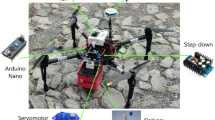Abstract
The location determination technique using time difference of arrival (TDOA) measurements has been widely used in the military and observation industry. The accuracy of geolocation estimation is a very significant problem because measurement data are affected by environmental noise. Environmental noise occurs due to measurement error and the non-line of sight (NLOS) problem. This paper presents a Kalman filter-based NLOS section identification method and an iterative estimation of emitter location using the recursive weighted least square (RWLS) algorithm. Using fixed receivers with known locations, we obtain TDOA data that contain environmental noise. We identify the NLOS section of each receiver using a Kalman filter. Using the identified line of sight (LOS) TDOA measurements, we accurately derive the estimated location of an emitter with a fast calculation speed using the proposed RWLS algorithm when we receive additional TDOA data. In order to confirm the performance of the RWLS algorithm, the presented simulation results show that the proposed technique achieves improved accuracy and speed for estimating the emitter location.






Similar content being viewed by others
References
Fang, B. T. (1990). Simple solutions for hyperbolic and related position fixes. IEEE Transactions on Aerospace and Electronic Systems, 26(5), 748–753.
Shen, G., Zetik, R., & Thoma, R. (2008). Performance comparison of TOA and TDOA based location estimation algorithms in LOS environment. In Proceedings of 5th workshop on positiong, navigation and communication (pp. 71–78).
Musicki, D., Kaune, R., & Koch, W. (2010). Mobile emitter geolocation and tracking using TDOA and FDOA measurements. IEEE Transactions on Signal Processing, 58(3), 1863–1874.
Kang, C., Lee, H., & Oh, C. (2009). NLOS signal detection algorithm for TDOA method in wireless sensor network. In International conference on advanced communication technology (pp. 901–904).
Shin, D. H., & Sung, T. K. (2009). Comparison of error characteristics between TOA and TDOA positioning. IEEE Transactions on Aerospace and Electronic Systems, 38(1), 307–311.
Lee, S. C., Lee, W. R., & You, K. H. (2010). TDOA/AOA based aircraft localization using adaptive fading extended Kalman filter algorithm. In Global conference on power control and optimization (pp. 363–367).
Le, B., Ahmed, K., & Tsuji, H. (2003). Mobile location estimator with NLOS mitigation using Kalman filtering. In IEEE wireless communications and networking conference (pp. 1969–1973).
Luo, J., Walker, E., Bhattacharya, P., & Chen, X. (2010). A new TDOA/FDOA-based recursive geolocation algorithm. In Proceeding of annual southeastern symposium on system theory (pp. 208–212).
Dogancay, K., & Hashemi-Sakhtsari, A. (2005). Target tracking by time difference of arrival using recursive smoothing. Signal Process, 85(4), 667–679.
So, H. C., & Hui, S. P. (2003). Constrained location algorithm using TDOA measurements. IEICE Transactions on Fundamentals of Electronics, Communications and Computer Sciences, E86–A(12), 3291–3293.
Ho, K. C., & Xu, W. (2004). An accurate algebraic solution for moving source location using TDOA and FDOA measurements. IEEE Transactions on Signal Processing, 52(9), 2453–2463.
Kay, S. M. (1993). Fundamentals of statistical signal processing: Estimation theory. NJ: Prentice-Hall.
Acknowledgments
This work was supported by the National Research Foundation of Korea(NRF) Grant funded by the Korea government (MSIP) (NRF-2016R1A2B4011369).
Author information
Authors and Affiliations
Corresponding author
Rights and permissions
About this article
Cite this article
Lee, K., Oh, J. & You, K. Closed-Form Solution of TDOA-Based Geolocation and Tracking: A Recursive Weighted Least Square Approach. Wireless Pers Commun 94, 3451–3464 (2017). https://doi.org/10.1007/s11277-016-3785-8
Published:
Issue Date:
DOI: https://doi.org/10.1007/s11277-016-3785-8




